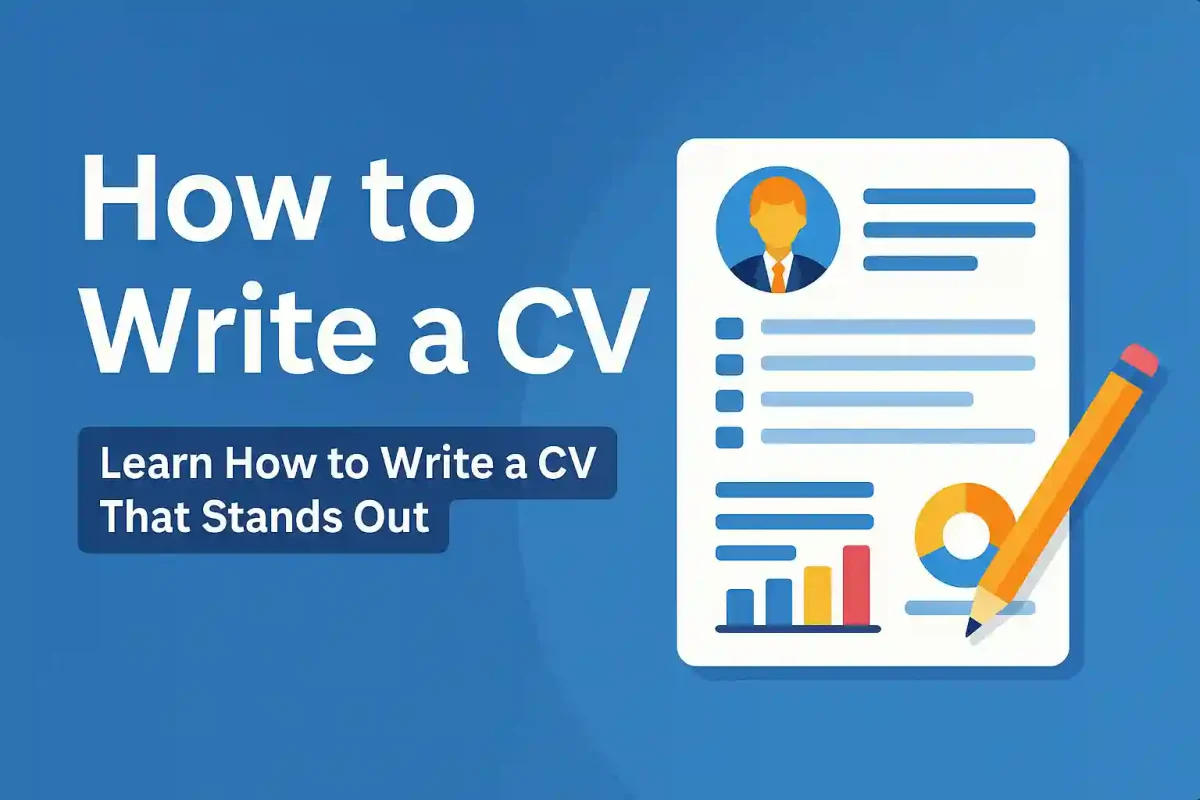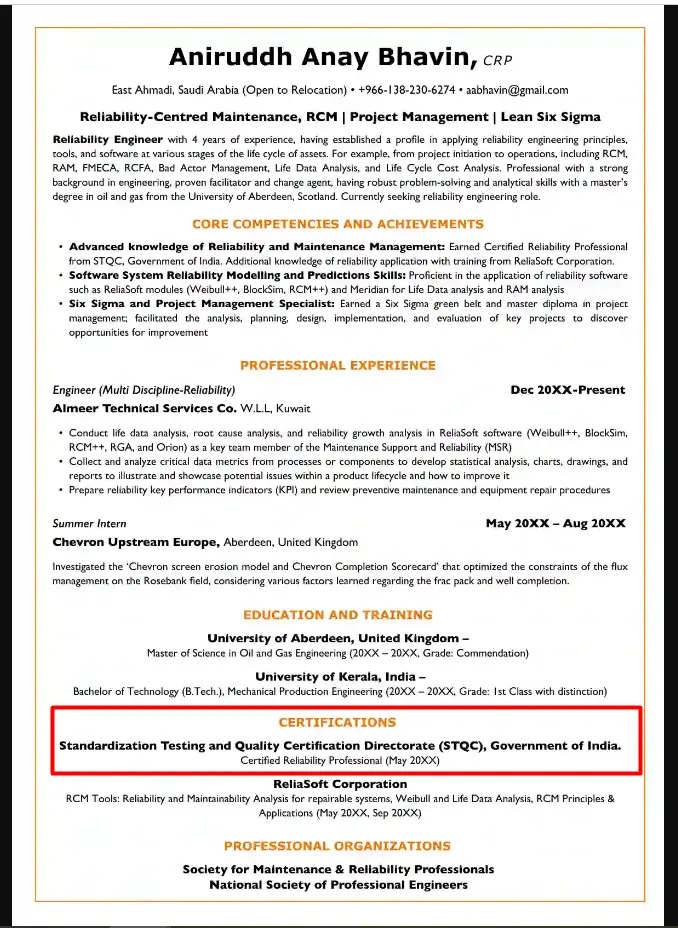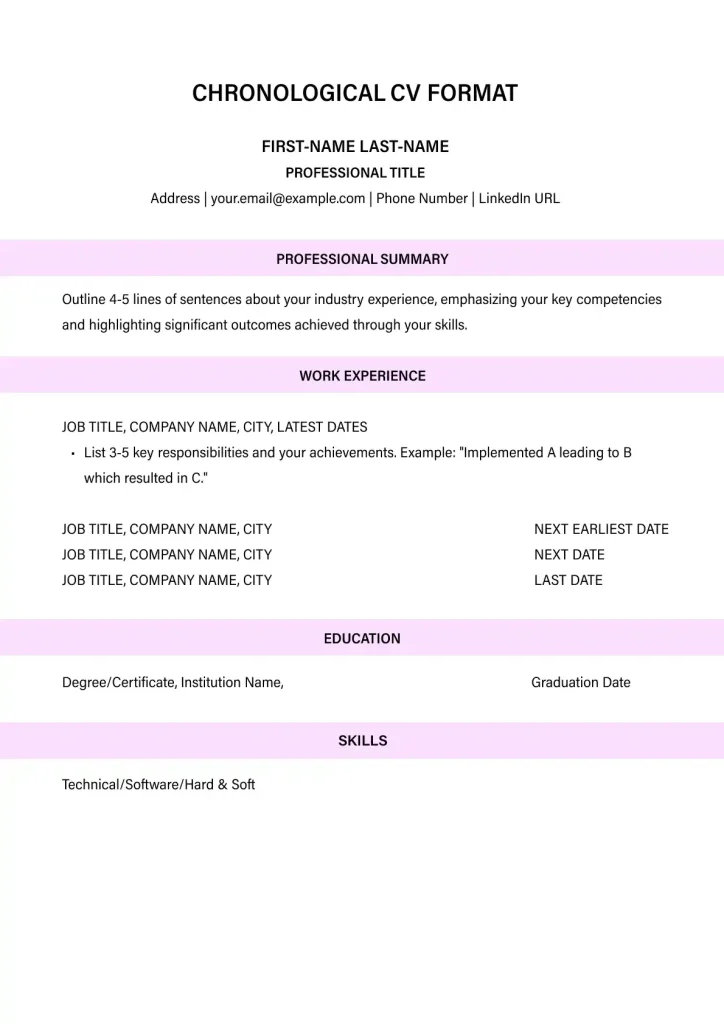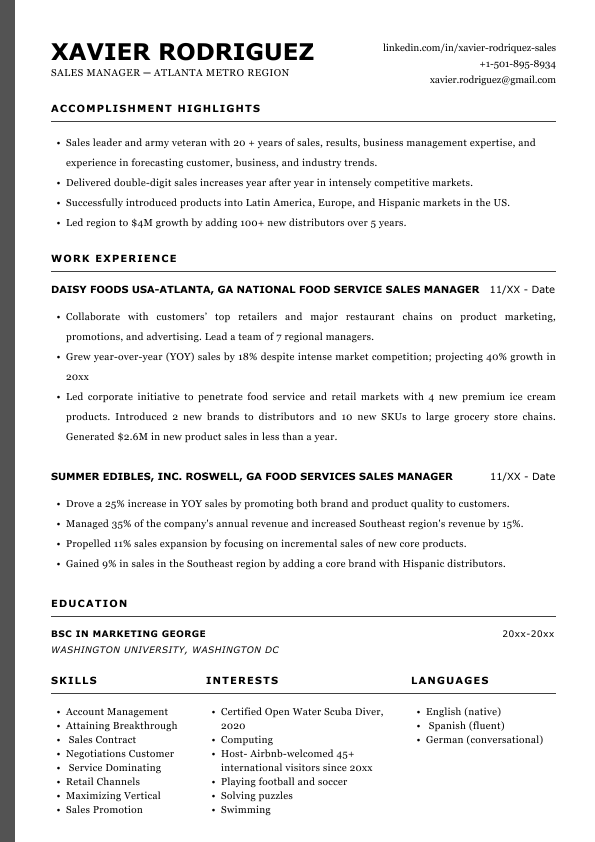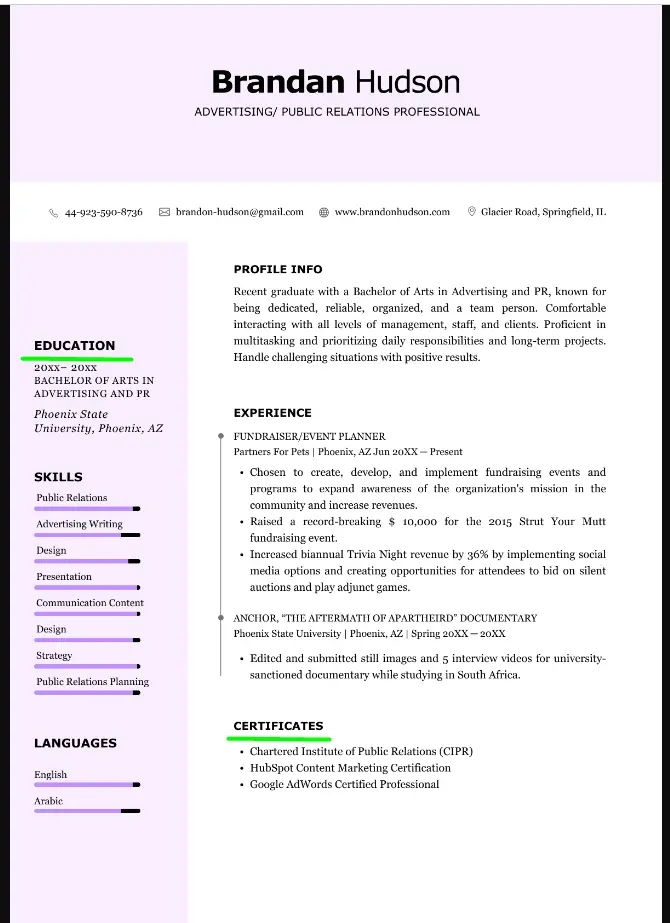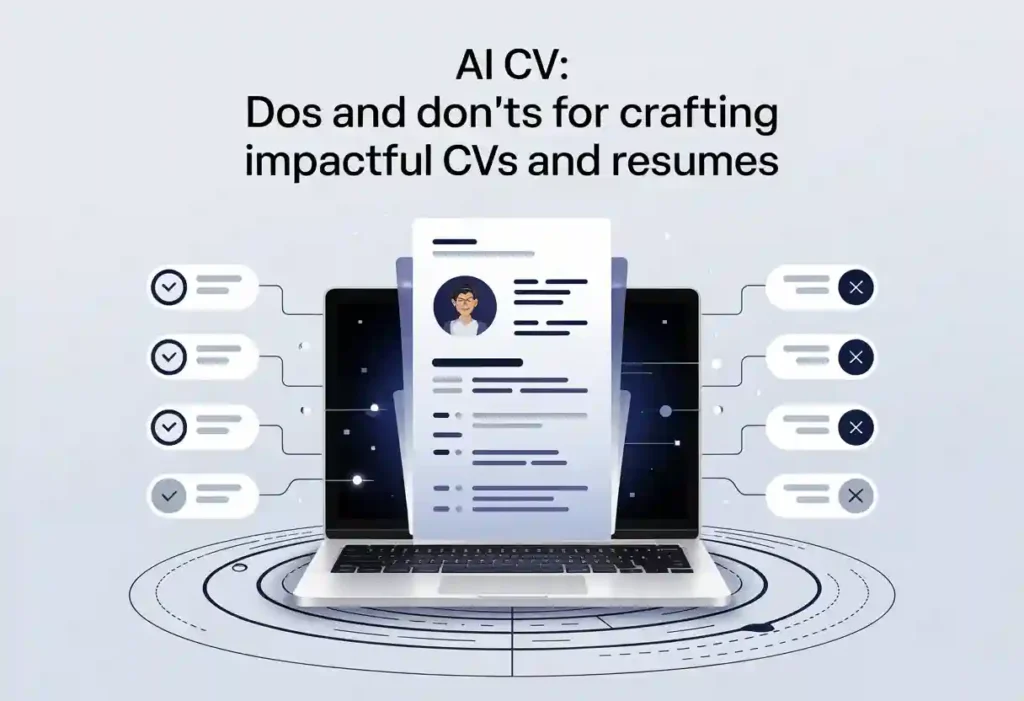Learn How to Write a CV That Stands Out
The not-so-secret ‘secret’ is that a well-written CV will always beat the competition. It can boost your chances of getting hired.
To do this, the first step is to:
- Tailor your CV to the job you’re applying for. You do this by highlighting your relevant skills and experience. That way, you can impress potential employers in seconds.
- Grab attention by using a clear and concise CV format with a top-notch profile summary. Sustain that interest by quantifying your achievements with statistics.
- Include keywords from the job posting to pass applicant tracking systems (ATS). Add power (‘doing’) words to showcase your unique value.
Read on to learn how to write your winning CV. This is a step-by-step guide. We provide more details on the tips above and CV examples for your inspiration.
CV vs Resume: Which One Do You Need?
Before you start, it’s essential to understand the difference between a CV and a resume. A CV, or curriculum vitae, is a detailed document. It outlines your entire academic and career history. Most people in Europe, Australia, the Middle East, Africa, and Asia use CVs. They use it for academic, research, and medical job applications.
In contrast, a resume is more concise. It is an abbreviation of your skills, experience, and education. Most applicants in the U.S. and Canada use resumes for target jobs.
When to Use a CV:
Applying for academic, educational, scientific, or research positions.
Applying for grants, fellowships, or scholarships.
Applying for positions abroad where CVs are preferred over resumes.
When to Use a Resume:
Applying for positions in the private sector.
Applying for positions abroad where they prefer resumes as the standard document.
Understand the differences. That can help you choose well between the two formats for all job applications.
Making the Perfect CV: Impress Hiring Managers in Seconds
To create a strong CV, it’s more than mere personal details, education, qualifications, work history, and skills. Focus on demonstrating your achievements and how you add value.
Showcase your personality and what you bring to the table that will benefit the employer.
Let’s kick off by going through the key sections of a curriculum vitae:
Compulsory Sections in a Good CV
Personal Information:
Include your contact details at the top of your CV:
full name (and professional title)
contact number
email address
location (city and country)
If you have a LinkedIn profile, include it in this CV section.
This is your digital handshake.
Professional Summary or CV Objective:
Provide a (brief) CV summary or objective highlighting your career goals and key abilities.
Personalise it to each job application to show why you’re the ideal candidate.
Think of this section as your elevator pitch, offering a snapshot of your career and aspirations.
Work Experience:
List your previous employment chronologically, starting with your most recent job.
Include job titles, company names, locations, and employment dates.
Use bullet points to describe your key responsibilities and corporate achievements.
Remember to use action verbs and keywords to align with the job you are interested in.
Education:
Detail your educational history, including the names of institutions, university degrees, graduation dates, and any honours or awards.
This section should reflect your educational background and qualifications.
Skills:
Mention both hard and soft skills in this section of your CV.
This will help you pass through applicant tracking systems (ATS) and catch the recruiter’s attention.
For instance, if applying for a marketing position, mention things like on-page and technical SEO, content creation, and analytical thinking.
Certifications and Licenses:
Include any relevant certificates or licenses that are a deciding factor for the job.
Credentials like Project Management Professional (PMP) or Certified Public Accountant (CPA) validate your expertise and dedication to your field.
Languages:
List all the languages you speak and your proficiency levels.
Language skills are a significant asset, opening doors to international opportunities and demonstrating cultural awareness.
Professional Affiliations:
Briefly mention any organizations related to the role and highlight your professional memberships or involvement in them.
This highlights your commitment to staying updated with industry trends and networking abilities.
Additional Sections in a CV
Depending on your industry and experience, you might want to include:
Projects:
Worked on a significant project? Include it! Mention your role, objectives, and outcomes.
Volunteer Experience:
Volunteer work can be vital for recent college graduates or those with gaps in their employment history.
Awards and Honours:
List any awards or honours you’ve received throughout your career.
This section can underscore your professional qualifications and accomplishments.
Choosing the Right CV and Format
The format and layout of your CV are crucial.
Choose a professional CV template that is easy to read.
Here are some tips:
Chronological CV Format:
Ideal if you have a strong work history.
It lists your work experience chronologically, starting with your most recent role.
This CV layout is excellent for demonstrating a steady career progression and relevant work experience.
Functional CV Format:
It focuses on skills and experience useful for career changers or those with gaps in their employment history.
Highlighting your key skills and professional achievements can help you pass the ATS.
Combination Format:
A mix of chronological and functional formats.
It highlights your skills and experience while also providing a chronological work history.
This balanced approach can appeal to the hiring manager looking for both a solid work history and relevant skills.

How to Write a CV Employers Are Impressed By
Your CV must show your unique value proposition (UVP) to make a strong first impression.
This is what sets you apart from other candidates.
Begin Strong:

Your CV personal profile or career summary should capture who you are and your career goals.
This summary (typically 3-4 sentences) should encapsulate who you are, what you bring, and your career goals.
As you write your CV, remember that this is one of the first CV sections the recruiters in most companies look for.
Make sure you align that job description and job title!
Here’s how:
“Dedicated and results-focused Marketing Specialist with over 5 years of experience developing and implementing fit-for-purpose marketing strategies. Proven track record of increasing brand awareness and driving sales growth. Looking to leverage acquired expertise in digital marketing and analytics to contribute to the success of ABC Company.”
Mention Results:
In CV writing, always use measurable achievements rather than just listing what you were responsible for in previous job roles.
Emphasise Results!
Use transition terms to mention outcomes and add measurable terms such as years on task, percentages, and monetary values.
Example:
“Successfully minimised loan risk for banking services through detailed risk analytics, reducing financial losses by 15%.”
Showcase Industry Insights:
Demonstrate your knowledge of industry trends and best practices.
This can be particularly important in fast-changing fields like technology, finance, and healthcare.
Example:
“Staying updated with the latest advancements in machine learning algorithms and their applications in financial modelling.”
Crafting a Compelling CV Personal Statement
Your personal statement is the first thing recruiters see.
Example:
“Top-achieving and dedicated Software Engineer with over 7 years of experience designing and implementing scalable software solutions. Proven track record of enhancing system performance and delivering high-quality applications. Seeking to leverage acquired expertise in full-stack development and cloud technologies to contribute to the growth of ABC Company.

CV Writing Advice for a Standout CV
Use Professional Fonts:
Choose something like Arial, Comic Sans, or Times New Roman, and keep the font size between 10 and 12 points.
Consistent Formatting:
Ensure consistent formatting throughout the CV, including the same font size, bullet style, font type, and heading size. To help achieve consistent formatting, use ‘Format Painter’, for example, in Microsoft Word.
Length:
Keep your CV to 1-2 pages unless you have extensive experience.
Proofreading:
Proofread all the information on your CV to ensure it is free from spelling and grammar errors.
Using CV Templates and Examples
An engaging CV template can help you quickly and easily create a good CV. There are many online CV builders and templates available that can guide you through the process. Here are some benefits of using CV templates:
- Professional Layout: Templates provide a clean and professional layout, ensuring your CV looks polished and well-organised.
- Time-Saving: Using a template saves time, allowing you to focus on customising the content rather than worrying about the CV layout.
- Showcasing Your Professional Experience

Your work experience is one of the most critical sections of your CV. Here is some guidance for showcasing your professional experience effectively:
Reverse Chronological Order: List your previous experience in reverse chronological order, starting with your most recent job.
Detailed Descriptions: Describe your responsibilities and achievements for each position. Use bullet points to make the relevant information easy to read.
Action Verbs: Use action verbs to describe your responsibilities and achievements. Words like “managed,” “developed,” and “implemented” can make your CV more dynamic and impactful.
Highlighting Your Skills
The skills section of your CV should highlight hard and interpersonal skills relevant to the job you are applying for.
Here are some suggestions for creating a strong skills section:
Relevant Skills:
Concentrate on the skills that are most relevant to the role.
Use keywords from the job advert to match your skills to the employer’s requirements.
For instance, if the job advert emphasises project management and data analysis, ensure these skills are prominently featured in your skills segment.
Balance:
Include a balance of hard/technical skills and soft/interpersonal skills.
This shows that you are a well-rounded candidate with a diverse skill set.
Hard skills could include software proficiency, language skills, or technical expertise.
Soft skills might encompass communication, teamwork, and problem-solving abilities.
Highlighting both skills can demonstrate your expertise in handling various aspects of the job.
Specific Examples:
Provide specific examples of how you have used your skills in your previous jobs.
This demonstrates your practical experience and expertise in applying your skills professionally.
For instance, if you mention your proficiency in a particular software, include a brief example of how you used it to achieve measurable results in your past job.
Showcase Transferable Skills:
Highlight interpersonal skills that are applicable across various industries and job roles.
These skills, such as leadership, time management, and adaptability, can make you a valuable asset in any work environment.
For example, “Managed a team of 10 employees, which improved departmental efficiency by 30%.”
Incorporate Keywords:
Use relevant keywords from the job description to optimise your CV for applicant tracking systems (ATS).
This increases the chances that the ATS will flag your CV as a good match and be seen by hiring managers.
For example, if the job advert mentions “digital marketing,” ensure this keyword is included in your skills segment.
Highlight Professional Skills:
Concentrate on technical skills that align with the job criteria and demonstrate your suitability for the role.
This could include industry-specific skills, certifications, or technical proficiencies that set you apart from other candidates.
For example, “Certified in Advanced Data Analytics and proficient in using SQL and Python for data-driven decision-making“
Following this guidance, you can create a skills segment that effectively highlights your qualifications and makes your CV shine to potential employers.

Education and Certifications
The education section of your CV should detail your academic background or qualifications, including the names of institutions, graduation dates, and any honours or awards. Here are some tips for this section:
Relevant Qualification: Highlight any education pertinent to the job you are applying for. This can include degrees, diplomas, and certifications.
Certifications and Licenses: Include any certifications or licenses relevant to the job. These can be a deciding factor for most employers.
Continuing Education: If you have taken any additional course(s) or training relevant to your field, include these in this section.
Using Power Words to Enhance Your Curriculum Vitae
Power words can make your CV more impactful and help it stand out to the recruiter. These action verbs effectively convey your achievements and expertise, making your curriculum vitae (CV) more dynamic and persuasive.
Accelerated: “Accelerated project completion by 20% through effective time management and resource allocation.”
Engineered: “Engineered a new software solution that increased productivity by 30%.”
Pioneered: “Pioneered a new marketing strategy that resulted in a 50% increase in brand awareness.”
Achieved: “Achieved a 25% increase in sales by implementing targeted marketing strategies.”
Implemented: “Implemented a new customer service protocol, leading to a 15% increase in customer satisfaction ratings.”
Spearheaded: “Spearheaded a cross-departmental team to streamline operations, reducing overhead costs by 10%.”
Transformed: “Transformed the outdated filing system into a digital database, improving data retrieval times by 40%.”
Managed: “Managed a team of 10 sales associates, resulting in a 20% increase in overall team performance.”

Crafting Your CV with Power Words
In writing your CV, seamlessly integrate power words into your job descriptions, profile summary, and skills section. This approach enhances your CV and demonstrates your proactive attitude and capacity to deliver results. Here’s how to do that:
Professional Summary: Start your CV with a summary of your compelling career achievements and aspirations. Use powerful words to highlight your expertise and impact.
Example: “Dynamic Marketing Manager with over 8 years of experience driving brand growth and spearheading innovative marketing campaigns. Successfully accelerated market penetration and achieved a 50% increase in customer engagement.”
Work Experience Section: Describe your responsibilities and professional achievements using power words. This section should reflect how much work experience you’ve garnered over the years, as well as your ability to contribute to the success of previous employers.
Example: “Managed a high-performing sales team that consistently exceeded quarterly targets, achieving a 30% increase in revenue.”
Skills Section: Use power words to emphasise your key skills and how they apply to the job you are seeking. This catches the recruiter’s attention and aligns your skills with the job description.
Example: “Implemented advanced SEO techniques that boosted website traffic by 40% and increased lead generation.”

Enhancing People Skills with Power (‘doing’) Words
Power words can also highlight your people skills, equally important in many job roles. Skills like leadership, communication, and teamwork can be effectively conveyed using action verbs.
Examples:
Led: “Led cross-functional teams to successfully launch new products, enhancing collaboration and achieving project goals ahead of schedule.”
Facilitated: “Facilitated training sessions that improved team competency and productivity by 15%.”
Communicated: “Communicated complex technical information clearly to non-technical stakeholders, resulting in better project alignment and execution.”
Incorporating power words into your CV is best practice and a strategic way to showcase your skills and achievements. Doing so optimizes every second recruiters look at your CV, ultimately enhancing your chances of securing your desired job.

How to Tailor Your CV for Different Industries
Creating a CV that stands out requires more than listing your professional qualifications and life experience. It’s essential to personalise your CV for different industries to match each job application’s specific job description and requirements.
This customisation helps you highlight the relevant expertise and jobs you’ve held in the past that make you the perfect person for the job. Here’s how to do it:
1. Research the Industry
Before you start tailoring your CV, research the industry you’re targeting. Understand the key skills, qualifications, and attributes that are most valued. This will help you align your CV with what potential employers in that industry are looking for.
Read Job Descriptions: Most jobs have requirements and keywords embedded in their adverts. This should give you a clear idea of what hiring managers are seeking.
Industry Trends: Stay updated with the latest industry trends and best practices. This shows prospective employers that you are knowledgeable and engaged with the current market.
Networking: Connect with professionals such as university alumni through LinkedIn and industry events. Networking can provide insights into what makes a successful candidate in your desired field.
2. Customise Your Professional Summary
Your professional profile or CV personal statement is one of the first things the recruiter sees. Tailor this section to emphasise your most relevant qualifications and experiences for the present job you’re applying for.
Use Relevant Keywords: Incorporate keywords from the job advert to pass through the ATS and catch the recruiter’s attention.
Highlight Industry-Specific Skills: Mention skills that are particularly important for the industry. For example, if you’re applying for a role in business administration, emphasise your organisational and project management skills.
3. Emphasise Relevant Work Experience
Customising your work experience section is crucial. Focus on past jobs that are most relevant to the present job you’re applying for.
Relevant Job Titles: List your previous experience in reverse chronological order, starting with the most recent experience directly related to the position.
Detailed Descriptions: Provide detailed descriptions of your key responsibilities and professional achievements pertinent to the industry. Use action verbs and quantify your accomplishments where possible.
Interpersonal Skills: Highlight interpersonal skills that are applicable across various roles within the industry. This can include leadership, problem-solving, and teamwork.

4. Highlight Industry-Specific Skills
Different industries prioritise different skill sets. Ensure your skills summary highlights the hard and soft skills most relevant to your desired job.
Technical Skills: For technical industries, list specific software or tools you are proficient in. For example, if you’re applying for a role in IT, mention your experience with programming languages, cybersecurity, or systems administration.
Soft Skills: Soft skills such as communication, adaptability, and teamwork are valuable in almost every industry. Adjust these skills to match the job requirements.
Certifications and Training: Include any additional qualifications, certifications, or training relevant to the industry. For instance, certifications in project management or specific technical skills can give you a competitive advantage.
5. Adapt the Education Section
Your educational background should be presented in a way that highlights its relevance to the industry you’re targeting.
Relevant Courses and Projects: Mention specific courses, projects, or research pertinent to the industry. For example, if you’re applying for a role in finance, highlight courses in accounting, economics, or financial analysis.
Academic Awards: Include any academic awards or honours demonstrating your expertise and dedication to the field.
6. Use a Suitable CV Template and Format
Your CV’s layout and format can also be tailored to different industries. Use a CV template that matches the industry’s standards.
Professional Layout: For corporate roles, use a clean and professional layout with a traditional font like Times New Roman or Arial. Ensure consistent formatting throughout the document.
Creative Layout: For creative industries, such as graphic design or marketing, you might use a more visually appealing CV template that showcases your creative skills.
7. Include Industry-Specific Sections
Adding industry-specific sections can make your CV shine even more.
Publications and Research: If you’re applying for academic or research positions, include a section detailing any publications or studies you have contributed to.
Projects: For technical or engineering roles, include a section on relevant projects you have worked on, detailing your role and the outcomes.

Example of Tailoring for Specific Industries
IT and Technology
Professional Summary: “Experienced IT Specialist with over 7 years in systems administration and network security. Proficient in Python, Java, and SQL. Proven track record of implementing innovative solutions to enhance system performance and security.”
Skills: “Cybersecurity, Network Administration, Cloud Computing, Python, SQL, Problem Solving.”
Certifications: “Certified Information Systems Security Professional (CISSP), CompTIA Security+.”
Marketing
Professional Summary: “Creative Marketing Manager with over 5 years of experience developing and executing successful marketing campaigns. Expertise in digital marketing, SEO, and content creation.”
Skills: “SEO, Digital Marketing, Social Media Management, Content Creation, Data Analysis.”
Certifications: “Google Analytics Certified, HubSpot Content Marketing Certified.”
Finance
Professional Summary: “Detail-oriented Financial Analyst with a strong financial modeling and risk assessment background. Proficient in Excel, SQL, and financial reporting.”
Skills: “Financial Analysis, Risk Assessment, Financial Modeling, Excel, SQL.”
Certifications: “Chartered Financial Analyst (CFA), Certified Public Accountant (CPA).”
Final Tips for a Standout CV
Crafting an impressive curriculum vitae in our present day takes time and effort, but it’s an essential part of your job search. Use these tips and examples to write your CV and stand out from other job seekers. Remember, your CV is your ticket to your next job interview, so make it count!
For more tips, explore our blog and try our free CV builder to create an outstanding CV. Our industry-specific and premium CV formats make your CV stand out!
Let CVJury help you create and customise your CV to get you interviews and your dream job.

For more ideas, explore our blog and try our free CV builder, which will help you create a CV that sets you apart.
Use our free cover letter builder, which helps you customise your cover letter for each job application, and our LinkedIn profile builder to achieve your career goal.
Further Reading: How To Write A CV
- Tired of applying for jobs without results?
- 51 best LinkedIn summary templates
- Common mistakes job seekers make
- Free online resume builder
- Best quality article on resume builder
References
- Little work experience? Here’s precisely how to phrase your soft skills.
- How to get work experience
